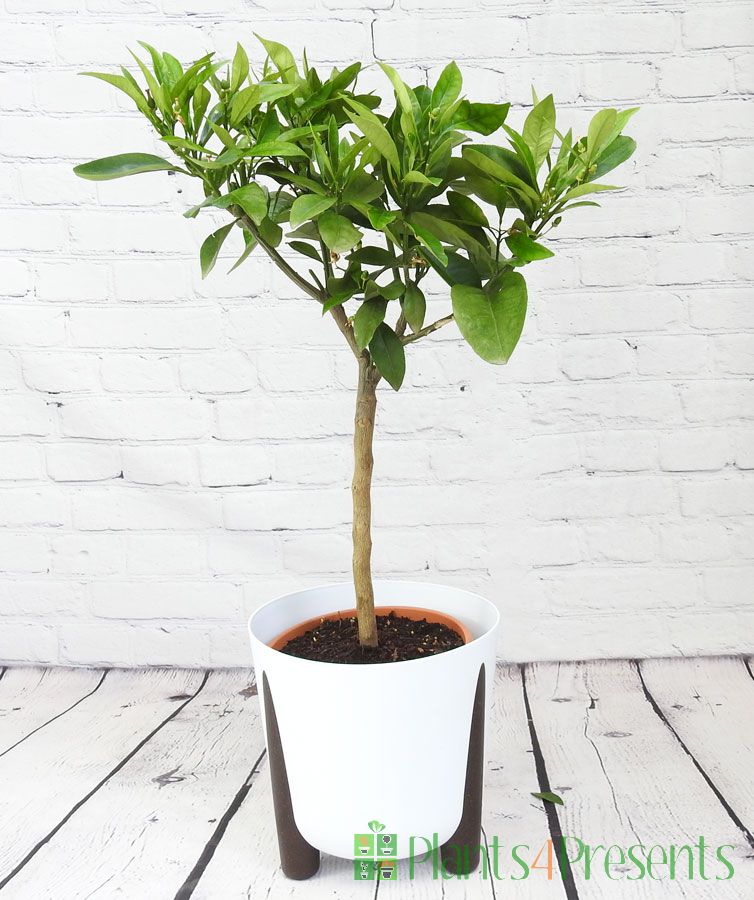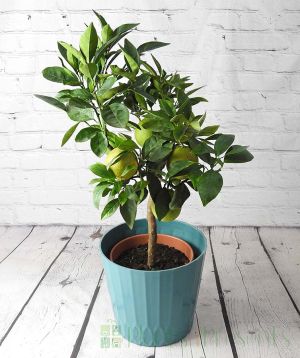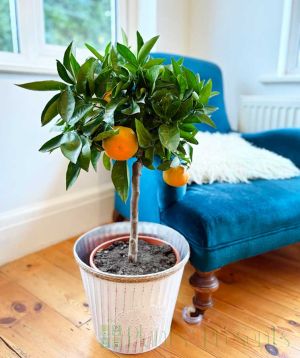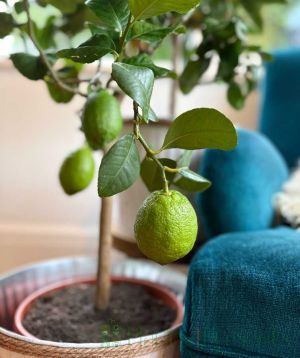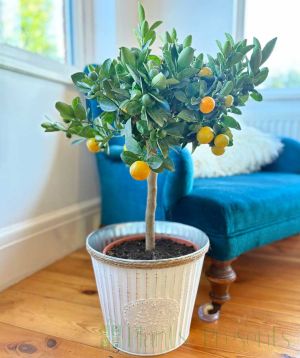Large Orange Tree
Out of stock


- Top Quality Sicilian grown plants
- Delivered gift wrapped and boxed with a handwritten greeting card
- Order by 3pm for next day delivery
This week's orange trees are nice strong plants with a bushy head of foliage and we expect them to flower and fruit again next year.
If you are looking for a sweet citrus tree with fruits on already both our Clementine trees and our Kumquat trees are looking great with several ripening fruits per plant.
Our large sweet Orange tree (Citrus aurantium 'Sweet Orange Group') is ideal for any citrus lover and produce really tasty oranges in the right conditions right here in the UK.
 4.9/ 5
129 reviews
4.9/ 5
129 reviews








Beautiful healthy plant.

A very healthy Large Orange tree with some small fruits forming and pushing some new growth plus buds forming. I couldn’t have asked for a better plant to be delivered.

Great service, lovely little tree that my my adores!

i wish it has more fruit, but it was pretty nonetheless

Plant arrived on time very well packaged in tip top condition in a very container

Beautiful plant! Lovely healthy plant & very well packaged for a specific delivery date.

Exactly as described, and arrived in great condition. My dad was very happy with his new orange tree for Father’s Day!

Beautiful tree and healthy

Great company and service. Plant was bought as a Christmas present for my mother and she absolutely loves it. Would definitely buy again!

Beautiful, healthy, full of leaf & growing in a lovely, sturdy pot.

These instructions are sent with the plant gift
This sweet orange tree (Citrus Sinensis) produces large orange fruit in the winter and fragrant white star shaped flowers in spring.
Citrus trees need lots of light. A conservatory is ideal, but they will also be happy near a window in a cool, bright room. In the summer and autumn, your citrus will thrive outdoors in full sun or partial shade. However, these trees are not hardy and will need to come inside as soon as the outdoor temperatures are near 5 degrees Celsius. When indoors, try to keep your plant away from cold draughts and any heating source.
Citrus are best kept in small pots here in the UK, they will need to be monitored regularly to check when the topsoil is dry. It is best not to have them on a routine water and let them tell you when they are next ready for a drink. When the topsoil is bone dry, remove the pot from the outer pot cover. Water thoroughly from the top until excess water drains right through the pot and out of the bottom and never leave your plant sitting in water. Sometimes if the soil is very compact this may take several waterings and is easiest to do in a kitchen sink. In the winter you should expect to water thoroughly still, making sure to soak the soil, but you might only need to do this once from anything between 1 to 4 weeks, depending on how quickly the soil dries out. In the summer months you may need to water every other day, but do not stand your plant in water. Don't worry if the soil feels dry between waterings, but if the leaves start to droop or curl you know it is thirsty, so water straight away. If you are having gradual leaf drop where you have a few leaves falling off each day, your plant is being overwatered.
In the summer, citrus trees will benefit from summer citrus feed every week to encourage growth, We use our Summer citrus fertiliser from March until the end of September. Through winter, from October until the end of February, we use the winter citrus fertiliser every time we water.
Citrus grow quite slowly; if you need to, repot in the spring only going up 1 pot size using a fast-draining compost suitable for container plants. As a general rule, citrus tend to produce flowers in late spring followed by small green fruits that can take 10 months or more to fully ripen. However, in this country, many varieties don’t follow a strict season and can fruit or flower at any point during the year.
Problem Solving
Citrus trees are not the easiest of plants but they are very rewarding. Look out for signs of trouble and try to treat problems early. The most common problem is leaves dropping due to over or under-watering. If leaves are crisp when they drop, this is due to underwatering; if they are leathery the chances are it has been over-watered. A return to a regular and thorough watering routine should lead to recovery.
If new growth is very light in colour or has mottled markings your plant may be lacking trace elements. A good dose of citrus feed should soon green up the leaves.
Our citrus trees are grown in a pesticide-free environment. In the unlikely event that you find pests, e.g. aphids, these can be removed by hand or with a soap and water spray. Check our recommended organic plant pest treatment for other pests here
We also have several pages and a video on more detailed citrus care here
More Information
Scientific Name:Citrus Sinensis
The true or "sweet orange" is Citrus Sinensis and there are many varieties including "Washington Navel" and "Valencia" amongst others
Sweet white blossom
Large sweet orange fruit
Oranges grow best in warm sub tropical conditions and require plenty of light to thrive. In the UK they do need protecting from cold temperatures and should be kept indoors in the winter months. However in a light room or on a summer patio they do surprisingly well.
http://ezinearticles.com/?History-Of-Citrus@amp;id=270715
The sweet orange is thought to have originated in china and to have been cultivated there for thousands of years. It was introduced to Europe in the 1400s and is now produced in huge quantites for fruit and juice in America and across Southern Europe and Turkey











